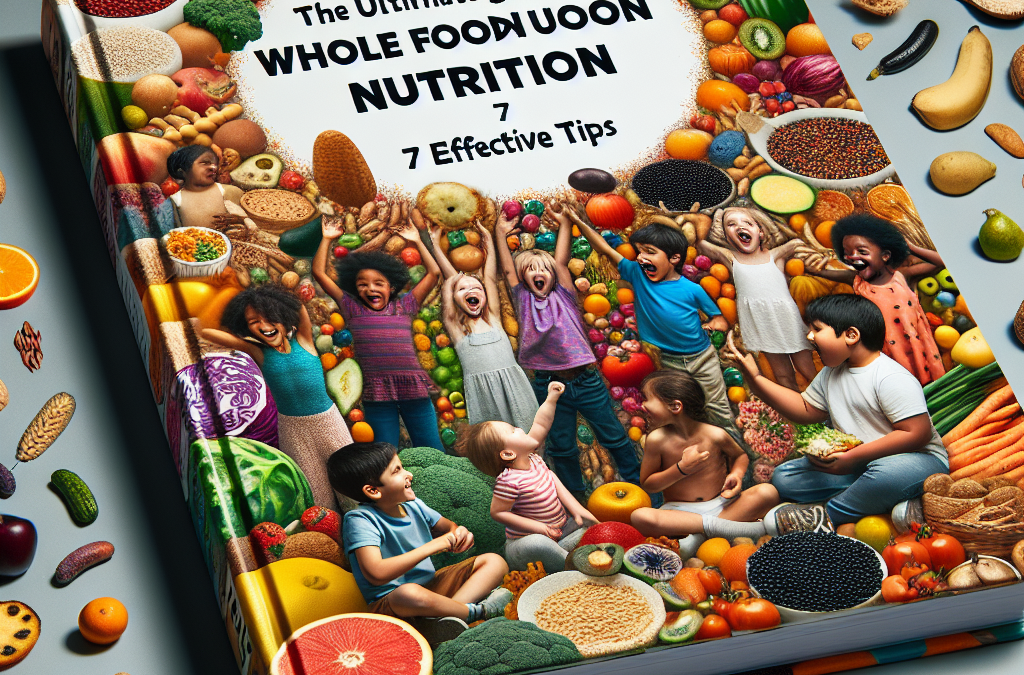1. Prioritize Fresh, Whole Foods
Choosing Nutritious and Whole Options
In 2025, one of the most effective strategies for promoting whole food nutrition for kids is to prioritize fresh, unprocessed foods. Fresh fruits, vegetables, whole grains, nuts, and lean proteins form the foundation of a healthy diet. These foods retain their natural nutrients and lack artificial additives that can be harmful over time.
Parents can start by shopping at local farmers’ markets or organic sections of grocery stores to access the freshest options. When children are offered a variety of whole foods early on, they develop a natural preference for nourishing choices that support their growth, immunity, and overall wellness.
Research shows that children who regularly consume fresh, whole foods tend to perform better academically, have stronger immune systems, and maintain healthier weights. Therefore, integrating these foods into daily meals is a cornerstone of effective whole food nutrition for kids.
Nutritional Benefits of Whole Foods
Whole foods are packed with essential vitamins, minerals, fiber, and antioxidants that processed foods often lack. For example, leafy greens provide calcium and iron, berries deliver vitamin C and antioxidants, and whole grains supply complex carbs and fiber. These nutrients are vital for proper development and long-term health in children.
In 2025, advancements in food technology make it easier than ever for parents to identify and select nutrient-packed whole foods, whether through smart apps or labels. Ensuring your child’s diet is rich in these foods can significantly influence their physical and cognitive development.
Incorporating a variety of colorful fruits and vegetables into meals not only boosts nutrition but also makes eating more engaging for kids. Remember, modeling healthy eating habits at home encourages children to make nourishing choices independently.
2. Develop a Balanced Meal Planning Routine
Creating Nutritious Weekly Menus
Meal planning is essential for maintaining consistent whole food nutrition for kids. By preparing weekly menus that incorporate a balance of proteins, healthy fats, carbohydrates, and produce, parents can ensure their children receive necessary nutrients daily. In 2025, digital planning tools help streamline this process, offering personalized dietary suggestions based on age and health needs.
Start by including a variety of whole grains, lean meats, dairy, and abundant fruits and vegetables. This not only prevents nutrient gaps but also helps children develop preferences for diverse foods. Setting a routine makes it easier for kids to anticipate healthy meals and reduce reliance on convenience or fast food options.
Involving children in meal planning can foster a sense of ownership and curiosity about healthy eating. Use visual charts or interactive apps to teach them about different food groups and their benefits.
Meal Prep Strategies for Busy Families
Effective meal prep is a game-changer for busy families aiming for whole food nutrition for kids. Preparing ingredients or entire meals in advance saves time and reduces the temptation to opt for processed snacks. For example, batch-cooking grains or chopping vegetables ahead of time ensures healthy options are always ready to serve.
By organizing shopping lists based on planned menus, parents can avoid impulse buying of unhealthy convenience foods. In 2025, smart grocery delivery and meal subscription services focus specifically on fresh, whole food options tailored for childrenâs needs.
Encouraging children to participate in meal prep promotes their understanding of nutritious eating and can make mealtime less stressful. Simple tasks like washing vegetables or assembling salads can make a big difference in fostering healthy habits.
3. Educate Kids About Whole Food Nutrition for Kids
Teaching the Importance of Nutrition
One of the most impactful steps in promoting whole food nutrition for kids in 2025 is education. Kids need to understand why their food choices matter. Use age-appropriate language and fun activities to teach children about how nutrients help their bodies grow, heal, and stay energized.
Involving children in discussions about banana benefits or how broccoli boosts immunity can encourage curiosity and positive attitudes toward healthy eating. Visual aids, stories, and games make learning engaging and memorable.
School programs and community workshops are additional avenues to reinforce these lessons, equipping children with knowledge beyond the home environment.
Practical Ways to Incorporate Nutrition Education
Practical education involves more than just facts; itâs about making healthy choices enjoyable. Create recipe challenges, vegetable tastings, or garden planting projects to help children connect to their food sources.
In 2025, many educational apps and interactive platforms provide virtual farm tours or nutrition quizzes tailored for kids. These tools make learning about whole food nutrition for kids fun and effective.
Parents can set up simple reward systems that acknowledge children trying new healthy foods, reinforcing positive habits and lifelong appreciation for nutritious eating.
4. Get Kids Involved in Cooking and Meal Prep
Hands-On Learning for Better Food Choices
Involving children in cooking and meal prep is a fantastic way to teach them about whole food nutrition for kids. When kids participate, they develop a better understanding of ingredients, cooking techniques, and healthy eating habits.
Start with simple recipes like vegetable wraps, fruit salads, or homemade smoothies. These activities are not only fun but also educational, illustrating how wholesome foods come together to create delicious meals.
Encourage kids to choose their ingredients, which boosts their interest and willingness to try new foods. Over time, theyâll gain confidence in making nutritious choices independently.
Building Skills and Healthy Habits
Cooking together strengthens family bonds and instills valuable skills such as measuring, chopping, and understanding flavor combinations. These skills promote mindfulness regarding food choices and portion control.
As children learn, they become more open to incorporating diverse whole foods into their diets. In 2025, intelligent kitchen gadgets and apps guide children step-by-step, making cooking accessible and educational.
Practical tips include setting up a child-friendly cooking station and emphasizing safety. Celebrating their accomplishments encourages continued engagement with nutritious meal preparation.
Get an Amazing Discount on the Best Certified Organic Whole Food Supplement!
5. Limit Processed and Artificial Foods
The Impact of Processed Foods on Kidsâ Health
Limiting processed and artificial foods is crucial for effective whole food nutrition for kids in 2025. Many processed snacks and fast foods contain added sugars, preservatives, and artificial dyes that can harm children’s health, affect mood, and impair cognitive function.
Research indicates that high intake of processed sugars correlates with increased obesity rates and difficulty concentrating in children. Cutting back on these foods can lead to better energy levels and improved behavior.
Parents should focus on offering whole, minimally packaged foods and reading labels carefully. Replacing chips with crunchy veggie sticks or flavored popcorn with homemade options can make a significant difference.
Practical Tips to Reduce Artificial Additives
Create a home environment that minimizes access to processed foods. Stock your pantry with whole grain crackers, nuts, fruit, and homemade treats to satisfy cravings healthfully. Educate children about food labels and the dangers of artificial ingredients.
In 2025, innovations in food labeling and transparency practices help consumers identify clean, whole food options more easily. Transparency from food manufacturers is a trend that empowers better choices.
Encouraging mindful eating, where children learn to recognize hunger cues and appreciate natural flavors, reduces the appeal of artificial snacks over time.
6. Create a Supportive Food Environment at Home
Stocking and Displaying Healthy Foods
A supportive food environment is key to fostering whole food nutrition for kids. Visible and accessible healthy options encourage kids to choose nourishing foods instinctively. Use clear containers and labeled sections for fruits, vegetables, nuts, and whole grains.
In addition, making healthy foods more appealing through colorful presentation and involving children in setting the table or arranging snacks can boost their interest. A home setup that emphasizes whole foods naturally influences preferences.
Eliminate or limit the availability of less healthy options to reduce temptation. Setting clear household rules about snack choices supports long-term habits.
Creating Routine and Boundaries
Establishing regular meal and snack times prevents overeating and ensures consistent nutrient intake. Consistent routines help kids anticipate balanced meals and reduce reliance on constant snacking or sugary treats.
Involving children in developing these routines gives them a sense of responsibility and understanding of nutritious eating. For example, planning snack times that include fruits, nuts, or yogurt supports healthy habits.
Supporting a positive food environment also means encouraging open conversations about food, avoiding guilt or pressure, and celebrating healthy choices to nurture a lifelong appreciation for whole food nutrition for kids.
7. Stay Updated With 2025 Nutrition Trends
Emerging Research and Dietary Guidelines
The landscape of nutrition is constantly evolving, especially in 2025 with innovative research and technology shaping dietary recommendations. For parents committed to whole food nutrition for kids, staying informed about the latest trends ensures your child’s diet remains optimal.
Recent studies emphasize the importance of microbiome-friendly foods, plant-based proteins, and personalized nutrition plans. Incorporating these into your child’s diet can enhance their health and resilience.
Subscribe to reputable nutrition journals, follow expert blogs, and attend community workshops to keep yourself educated about the best practices for 2025.
Incorporating Technology for Better Nutrition
In 2025, smart apps and wearable devices help monitor kids’ dietary intake and track nutritional values in real time. Gamified learning platforms make understanding whole food nutrition for kids more engaging and accessible.
These tools can suggest recipes, track growth, and suggest adjustments based on individual health needs. They empower parents and children to make informed decisions seamlessly.
Adapting to these technological advancements ensures your family stays aligned with the latest in nutritional science, promoting lifelong healthy eating behaviors.
Conclusion
In 2025, prioritizing whole food nutrition for kids remains one of the most effective ways to support their growth, development, and overall health. From choosing fresh, unprocessed foods to educating your children and staying updated with the latest trends, these seven tips provide a comprehensive roadmap for nourishing your kids effectively. Remember, fostering healthy habits today ensures a healthier future, and your proactive efforts can make all the difference. Embrace these strategies to give your children the best start toward lifelong wellness through whole food nutrition for kids.
Frequently Asked Questions
1. Why is whole food nutrition for kids so important in 2025?
Whole food nutrition for kids in 2025 is vital because it provides essential nutrients free from artificial additives, supporting their growth, immunity, and cognitive development. Modern food trends and research emphasize minimally processed foods for optimal health.
2. How can I get my kids interested in eating more whole foods?
Engage children in meal planning, involve them in cooking, and make colorful, attractive presentations. Educational games and involving them in grocery shopping also encourage curiosity and acceptance of whole foods.
3. What common processed foods should I avoid for my child’s health?
Limit foods high in added sugars, artificial colors, preservatives, and unhealthy fats, such as sugary cereals, candy, chips, and fast foods. Focus on natural and minimally processed options instead.
4. How can I stay updated on the latest whole food nutrition tips for kids in 2025?
Follow reputable nutrition sources, subscribe to industry publications, use nutrition apps, and participate in community workshops. Staying informed helps you make the best choices for your child’s health.
5. What are practical ways to limit processed foods at home?
Stock your pantry with whole foods, cook meals from scratch, read labels carefully, and set household rules about snack choices. Engage kids in preparing healthy snacks and meals.




